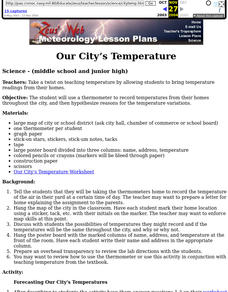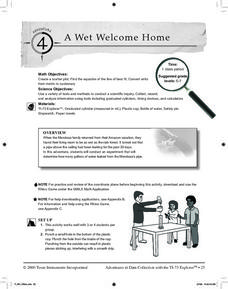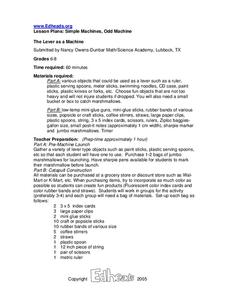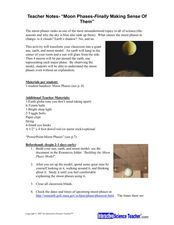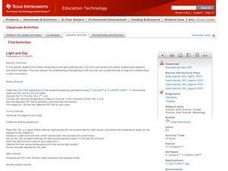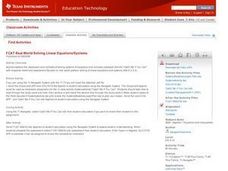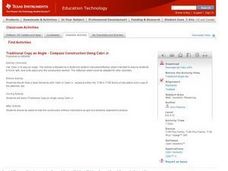Curated OER
Our City's Temperature
Middle schoolers use a thermometer to record temperatures from their homes throughout the city, and then hypothesize reasons for the temperature variations. They use a weather graph worksheet that's imbedded in this lesson to orgainize...
Curated OER
A Wet Welcome Home
Students investigate data collection and analysis. In this Algebra I lesson plan, students create a scatter plot and find the equation of best fit in a simulation of a leaking water pipe.
Curated OER
Is the Hudson River Too Salty to Drink?
Students explore reasons for varied salinity in bodies of water. In this geographical inquiry lesson plan, students use a variety of visual and written information including maps, data tables, and graphs, to form a hypothesis as to why...
Curated OER
Simple Machines, Odd Machines
Students recognize and identify common objects that can be used as a lever. In this simple machines instructional activity, students experiment with materials to design and construct a machine that uses a lever. Students also design and...
Curated OER
Physics: Forces and Motion
Students recognize the effect of Earth's gravity on an object's weight. In this force and motion lesson students understand the role of gravity when you drop an object. Students experiment with small items. Students measure in Newton's....
Curated OER
Moon Phases - Finally Making Sense of Them
Young scholars investigate the different phases of the moon. In this lunar cycle lesson, students create models of the sun, earth and moon and investigate why we observe the moon the way we do. Young scholars observe a...
Curated OER
Electromagnetic Pick-up
Students investigate electromagnetic energy. In this magnetism instructional activity, students will create an electromagnet and test changes with increased energy. They will compete by building the strongest electromagnet.
Texas Instruments
Light and Day
Pupils explore the concept of collecting data as they collect data on their graphing calculator about time, temperature, and light. Learners plot the data and create histograms and box and whisker plots to analyze the data.
Curated OER
FCAT Real World Solving Linear Equations/Systems
Pupils relate real life situation to the equations, graphs and inequalities. They model real life scenarios using matrices and draw conclusions from their data. This lesson plan is aligned with FCAT.
Curated OER
Getting Started with the TI-Navigator™ System: What's My Line?
Learners analyze linear functions in this algebra lesson. They explore the meaning of slope and the slope-intercept form of a line as they investigate the effect changing parameters on the graph of a linear function.
Curated OER
Rational Numbers
Young scholars investigate rational numbers in this algebra lesson. They graph systems of equations and use technology to find the point of intersection. They need a TI for this assignment.
Curated OER
Exploration of Trigonometry
Learners explore how changing an angle in a triangle changes the ratio of the sides. They also explore how changing the sides can make changes to an angle in a triangle. Finally, they determine how two different pairs of sides, in the...
Curated OER
Show Me the Money
Pupils investigate financial applications of mathematics in this mathematics lesson plan. They will investigate equations that represent a company’s income, expense, and profit functions and use those equations to identify break even...
Curated OER
Fraction Decimal Challenge
Pupils explore the concept of fractions and decimals as they try to find as many fractions as possible that are equivalent to .25. Learners use their calculator to take screen shots and send them to the teacher via Ti-Navigator. They...
Curated OER
Estimating with Rational Numbers
Students explore the concept of rounding. In this rounding lesson, students round fractions and mixed numbers. Students estimate the sums, differences, products, and quotients of rounded fractions and mixed numbers.
Curated OER
Circles all Around
Students investigate circles. In this middle school mathematics lesson, students explore the relationship between the diameter of a circle and its circumference.
Curated OER
Dimensions and Area
Learners explore the area of rectangles in this middle school geometry lesson. They will investigate the relationship between a change in the dimensions of a rectangle and the change in the corresponding area. Learners also investigate...
Texas Instruments
Traditional Copy an Angle - Compass Construction Using Cabri Jr.
Learnerss explore geometric construction in this geometry lesson. They will investigate the traditional construction for copying an angle using Cabri Jr. in lieu of paper and pencil construction. The lesson encourages learners to explore...
Texas Instruments
What's the Scale?
Pupils will analyze scales as related to models and real life in this geometry lesson. They work together to compare the dimensions on a model as compared to the real building.
Curated OER
Count Them Up
Pupils calculate area using the geoboard application on their calculators. They use a TI-73 calculator to find the areas of the shapes provided in the accompanying worksheet. Screen shots and instructions for creating shapes in the...
Curated OER
Does Clear Water mean Healthy Water?
Learners test their local aquatic site to determine its water clarity. They collect a water sample and measure its turbidity using a sensor, then they repeat the experiment to obtain a second turbidity reading to find the average value.
Curated OER
Match Me!
Young learners explore motion graphs in this lesson. They investigate distance-time plots as they move in a specific way in front of the CBR in an attempt to make a motion plot that matches a given plot. Pupils explore the connections...
Curated OER
Planets in Proportion
Students apply estimation strategies and proportional reasoning to determine a scale comparing the planetary bodies to Earth. They convert measurements of time and distance using scientific notation. Both the metric and customary units...
Curated OER
Fraction Fun
In this fraction practice worksheet, young scholars use a matrix of different noises found in 5 towns. Students determine what fraction of the towns are experiencing noise problems and write the fraction for each town.
